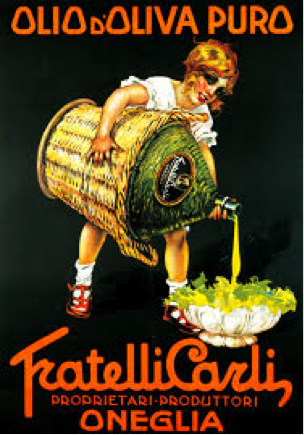There is a popular generalization about Italian cooking that assigns butter to the north, olive oil to the south, and lard to the middle regions of the country, but this doesn’t begin to do justice to its complexity. The generalization, I was told, had to do with an earlier time, before refrigeration, when it was more difficult to keep and work with butter in the southern regions. Differences in Italy’s regional cuisines might also be traced to geography or political differences since its geography includes alpine, maritime, and even desert regions and the country wasn’t unified politically until 1861. Whatever the reasons, this small country has an incredible diversity of culinary styles from German- influenced food in the Tirol to the food of Rome’s Jewish ghetto and the savory African influences of Sicily.  A quick visit isn’t likely to raise your awareness of those vast differences in Italian food cultures either. One might be disappointed if that visit is to Tuscany where every menu looks identical and the bread is bland because it’s made without salt. On the other hand, in Emilia-Romagna dishes up the staples of world-famous Italian products – prosciutto from Parma, parmesan cheese from Reggiano and balsamic vinegar from Modena. A culinary journey through Italy is varied and tasty. I thought I knew something about Italian food; after all I once owned and ran a small Italian bistro. But, it turns out I didn’t know anything about Roman cuisine until my current stay in Rome. I wasn’t aware, for instance, that lightly fried vegetables – squash blossoms, cauliflower, broccoli, and zucchini – are a common antipasto offering. In addition, I had no clue as to the influence of Rome’s Jewish ghetto on its cuisine. Since M and I arrived, fried artichokes with their delicate, crunchy texture and carmelized sweetness have become one of our favorite side dishes at dinner.
A quick visit isn’t likely to raise your awareness of those vast differences in Italian food cultures either. One might be disappointed if that visit is to Tuscany where every menu looks identical and the bread is bland because it’s made without salt. On the other hand, in Emilia-Romagna dishes up the staples of world-famous Italian products – prosciutto from Parma, parmesan cheese from Reggiano and balsamic vinegar from Modena. A culinary journey through Italy is varied and tasty. I thought I knew something about Italian food; after all I once owned and ran a small Italian bistro. But, it turns out I didn’t know anything about Roman cuisine until my current stay in Rome. I wasn’t aware, for instance, that lightly fried vegetables – squash blossoms, cauliflower, broccoli, and zucchini – are a common antipasto offering. In addition, I had no clue as to the influence of Rome’s Jewish ghetto on its cuisine. Since M and I arrived, fried artichokes with their delicate, crunchy texture and carmelized sweetness have become one of our favorite side dishes at dinner.
Archive for Work and Adventure – Page 29
Travel is enriching but, like chocolate mousse, sometimes it’s too rich to digest. It’s better in small delectable, melt in your mouth bites. Too much of a good thing diminishes the power to amaze. Rome is that way. It’s the chocolate mousse of European travel. So, pace yourself and think about taking small bites.
Italy is a feast for a lover of history. There are archeological digs, landmark buildings, walls, roads, and artifacts from different historical periods, painting, sculpture and architecture spanning millennia, a landscape that seduces, and a cuisine that delights. Rome, in particular, offers a rich diet of Etruscan, Roman, and Renaissance treasures that cry out to be tasted. read more
Graham Greene said it best in The Third Man:
“In Italy, for thirty years under the Borgias, they had warfare, terror, murder, and bloodshed, but they produced Michelangelo, Leonardo da Vinci, and the Renaissance. In Switzerland they had brotherly love, they had five hundred years of democracy and peace – and what did they produce? The cuckoo clock.”
Greene was right. Italy is unruly and categorically different from its smoothly oiled, efficiently organized, neatly manicured Swiss neighbor. Yet, in spite of the chaos, inconvenience, confusion, corruption, and union strikes that disrupt some essential function nearly every day, it will charm you. It looks good, feels good, and above all it tastes good. Love it or hate it in the beginning, I guarantee that if you look for the good things and don’t expect perfection you will end up loving it. read more
“Slow down, you move too fast
You got to make the morning last,
Just kicking down the cobblestones
Looking for fun and feelin’ groovy…
Got no deeds to do
No promises to keep.
I’m dappled and drowsy and ready for sleep.
Let the morning time drop all its petals on me.
Life, I love you,
All is groovy.”
Paul Simon got it right… and something made me dig into my unconscious for those words (59th Street Bridge Song) while sitting at a sidewalk caffe’ in Rome stressing out about the lack of a good Wifi connection. read more
Geography is destiny – Abraham Verghese in Cutting for Stone
The most interesting, literate, progressive, and beautiful places on earth are not necessarily those that are furthest away. When asked to pick a city with these attributes the list will likely include Paris, London, Rome, Berlin, Copenhagen, Singapore, Hong Kong, Capetown, San Francisco and others but never, until lately, has Seattle cracked my Top Ten. Surviving Seattle has always been my mantra because of the weather, but I’m rethinking that in view of a recent epiphany. read more
About Me
What's New
“Working toward what I’m leaving behind.” Nick Cave (Artist)







































